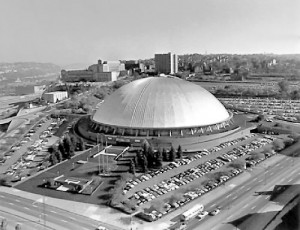
Around Town: Point of Realism Interferes With Preserving Arena
Around Town: Point of Realism Interferes With Preserving Arena
The Civic Arena can still pack ’em in. It was standing-room-only last week at the Pittsburgh Historic Review Commission meeting on Ross Street, just down the hill from the vacated hockey palace.
Some very smart people made a polished and impassioned presentation that showed the 49-year-old Igloo to be an architectural superstar, an engineering marvel and the symbol of Pittsburgh’s Renaissance, rising just as the city’s skies were clearing.
What nobody offered, though, is what practical use it has now. In the past quarter-century, three multipurpose arenas of ascending size — the 5,400-seat Palumbo Center, the 12,500-seat Petersen Events Center and the 19,000-seat Consol Energy Center — have been built within two miles of the place.
This city needs another arena like it needs a hole in the Hill.
To be fair, it wasn’t the job of preservationists this day to offer a practical new use for the empty building. The question was whether the Civic Arena should be designated a historic structure.
But if the commission votes next month to grant historic designation (preliminary approval last month is no guarantee), that would prevent the city-county Sports & Exhibition Authority from demolishing the arena. That would muck up the Penguins’ development plans for the 28-acre site, and the most prominent Hill District leaders don’t want those plans blocked. Residents have been waiting 50 years to get their neighborhood back.
Both preservationists and those who want to see office buildings, stores and about 1,200 new homes built at the site agree on one thing: The way the Hill District was treated when the arena site was cleared in the 1950s was a civic crime. About 1,300 buildings, 400 businesses and 8,000 lower Hill residents got the heave-ho. Promises of better housing were never kept, and the highway ditches and largest park-for-pay lot in Western Pennsylvania are the neighborhood amputation scars.
Rob Pfaffmann, the Downtown architect who has spearheaded the Reuse the Igloo campaign, suggests that keeping the building can help future generations remember that painful history. He quoted the native son who did the most to celebrate the neighborhood, the late playwright August Wilson, who said, “My plays insist that we should not forget or toss away our history.”
Mr. Pfaffmann even broke out a Rick Sebak video on the arena. (The video player, like the Igloo’s acoustics, went awry shortly.) But neither Mr. Pfaffmann nor the city’s premier architectural storyteller, Franklin Toker, could persuade Hill leaders that this mammoth steel assemblage would be anything but a humongous kink in plans to reknit the neighborhood into Downtown.
City Councilman Dan Lavelle said the commission’s mission statement also speaks to the preservation of neighborhoods. He hoped it would pay attention to community residents rather than those with fond memories of coming to the lower Hill “to listen to the Beach Boys at the expense of those who lived there.”
This “case study of urban renewal gone wrong,” which isolated and divided the Hill, is “not the sort of history we wish to preserve,” Mr. Lavelle said. Preserving it, he said, would be like flying Confederate flags on state buildings in the South.
Paying $50,000 a month to maintain it, or tens of millions of dollars to modify it for a new use, would not be a smart move for a strapped city, he concluded.
What do you do with a spare arena? Modification plans all seem a bit like getting a bear to ride a bicycle. It can be done, but that’s not really what either bears or bicycles are for.
What about saving part of it? TV actor David Conrad, in a videotaped presentation, said he understood why neighborhood residents want the arena erased, but saving a piece could “transform an insult into pride.” Preservation of a remnant would be akin to the iconic murals of saints, he said, which often show the martyred figures holding the very weapons that killed them.
Sala Udin, who formerly held the council seat in the Hill, didn’t think the neighborhood would oppose a “remnant that stayed as some kind of icon.” But full preservation would block development plans.
Penguins President David Morehouse said preserving a remnant, as was done with the Forbes Field outfield wall, is possible, but “you can’t have half of a dome in the middle of your development.”
The Hill’s comeback has to be the primary goal. That started more than 20 years with the hugely successful Crawford Square townhouse development just east of the arena. With gasoline prices soaring, building another 1,200 new homes in the heart of the region is about the best news a shrinking city could get.

